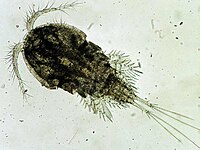Nauplius

The primary larva ( ovoid ) of the crustaceans , which is characterized by three pairs of legs and an unpaired median eye ( nauplius eye ), is referred to as nauplius (Pl. Nauplii) or nauplius larva . This typical larva is a characteristic that justifies the compilation of all crabs into a group ( taxon ), since it is found in all crabs with the exception of tongue worms (pentastomida) at least during development in the egg. Accordingly, this feature represents an autapomorphism of the crustaceans.
The name goes back to OF Müller . For the ancient scholar Pliny , "Nauplius" is an aquatic animal that uses its shell like a sail .
Habitus
Nauplii have a spherical to egg-shaped habit and, in contrast to adult crustaceans, only have three pairs of extremities (first antenna , second antenna and mandible ). The second antenna, which has been converted into large swimming legs, is particularly striking. A characteristic feature of the nauplius is its simply present eye ( ocellus ), located centrally on the forehead, which consists of three pigment cup-o-cells and is known as the nauplius eye. In most nauplii, the mouth opening is covered by a large upper lip ( labrum ). The rear end of the larva forms the trunk-telson system, from which new segments with pairs of legs sprout in the further course of development via teloblastic growth ( anameria ).
development
In many small crustaceans, the nauplius forms the hatching stage with small eggs, in other crustaceans the nauplius is only an early larval form in the egg. The development of the nauplii to the finished, adult cancer takes place differently in the different cancer groups, over up to eight stages of nauplius.
In the more original taxa, the larvae develop over several moults, with additional segments and pairs of legs being added. In the course of its growth, a metanauplius larva develops in which only the first three pairs of limbs work, but other extremities are present as non-functional systems.
Other taxa are characterized by metamorphosis and various typical larval forms. After six classic stages of nauplius , the copepods (Copepoda) suddenly form a larva that already looks very similar to the adults and is called a copepodite . The development is complete after five more Copepodit stages.
The larvae of most decapods go through a very big change . In them, the larva hatches out of the egg at a very advanced stage, the Zoëa larva . The adult crabs develop through an encompassing metamorphosis.
Also, such a complete transformation, but in a much more drastic form, can be found at the stuck barnacles ( barnacles , barnacles ) and the root of cancers in which the development of a free-floating ( planktonic ) Nauplius form a Cypris larva takes place for Adultus.
Way of life
With a few exceptions, nauplii are planktonic and move in a vertical posture. To do this, the antenna and mandible strike in a metachronic rhythm. The antennae are used for balance. Free-swimming nauplii feed on tiny plankton , which are mainly captured by the mandibles.
Aquaristics
Nauplii of brine shrimp Artemia sp . are often used by aquarists as fish feed .
swell
- Alfred Kaestner: Textbook of special zoology . Ed .: Hans-Eckhard Gruner. 4th edition. tape 1 : invertebrates; 4th part: Arthropoda (without Insecta). Gustav Fischer Verlag, Jena Stuttgart New York 1993, ISBN 3-334-60404-7 , p. 513-521 .
Individual evidence
- ↑ a b c Ulrich Lehmann : Paleontological dictionary . 4th edition. Ferdinand Enke Verlag, Stuttgart 1996, p. 151 .

